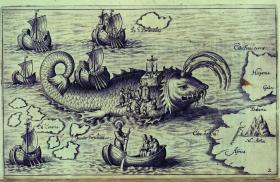Religious meaning
Published in Features, Issue 4 (Jul/Aug 2008), Medieval History (pre-1500), Volume 16
St Brendan and his crew on a whale—from Nova typis transacta navigatio: Novi Orbis India Occidentalis, originally published in 1621 by Honorius Philoponus. (British Library)
In the transition from paganism to Christianity, Hy Brasil took on another meaning. The Celtic ideal of the island of the Otherworld—a place with all good things, a land of eternal youth, an environment of dreams and fantasies—is incorporated into the concept of an earthly paradise.
It was in search of this promised land that the Irish monk St Brendan, also known as the navigator saint, would have embarked on his fabulous adventure in the sixth century. With St Brendan we find the fusion of the Celtic idea of a land of eternal life in the west with the earthly paradise and the promised land mentioned in the Bible. The land allegedly discovered by St Brendan became associated with Hy Brasil. The paradise, which for many years lived in pagan dreams, was finally found by the holy man. Although not mentioned in the old manuscripts, which retell the saint’s journey, the island over time also became referred to as Hy Brasil of St Brendan.
















